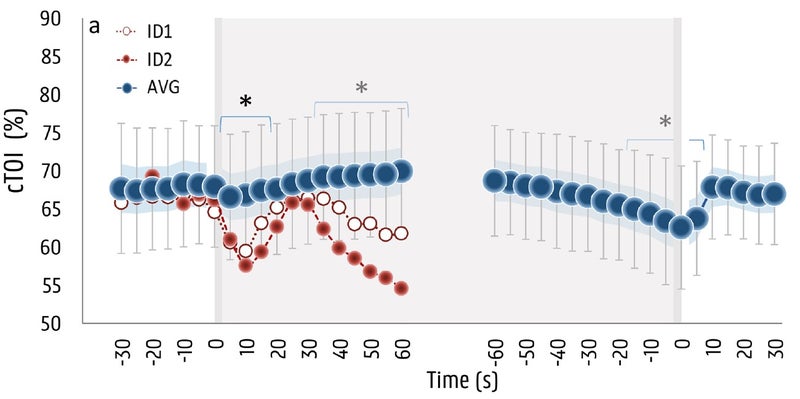We all know what it feels like to run out of oxygenтАФor at least, what it feels like to feel like weтАЩre running out of oxygen. In reality, the breathlessness we experience during hard exercise, or at high altitude, or when simply holding our breath, has more to do with too much carbon dioxide in the blood than with too little oxygen. As the feats of elite freedivers showтАФlike holding a single breath for тАФour limits arenтАЩt what they seem.
IтАЩve long been fascinated by studies of , what defines their limits, and how those skills may translate to other environments like high altitude. But their abilities are so outlandish that it feels like studying another species. So I was particularly interested to see that looked at breath holding in regular people with no prior training in it. The study is very straightforward, taking measurements of heart rate and oxygen levels while volunteers hold their breath, and it offers a revealing picture of how the body copes with a shortage of oxygenтАФand what can go wrong.
The research was performed at Ghent University in Belgium, by Janne Bouten, Jan Bourgois, and Jan Boone. (IтАЩm assuming scientists in Belgium are assigned to different departments by alphabetical order.) They asked 31 volunteers (17 men, 14, women) to hold their breath for as long as possible three times in a row, with two minutes break each time. Typically people get better and better in repeated breath holds, in part because their spleens are squeezing more oxygen-carrying red blood cells into circulation. During the third and final breath hold, they took continuous measurements of parameters including heart rate, oxygen levels in the brain, and oxygen levels in the leg muscles.
Humans, like other mammals, have a тАЬdiving responseтАЭ that kicks in when you hold your breath, with the goal of making sure your brain always has enough oxygen. As the researchers point out, if your circulation stops abruptly, youтАЩll be unconscious within 30 seconds and suffer irreversible damage within two to ten minutes. The diving response is enhanced if your face is submerged in water, but it happens even on dry land. Your heart rate drops, and the blood vessels leading to non-essential parts of the body like your leg muscles constrict in order to redirect crucial blood (and oxygen) to the brain.
The subjects held their third breath for an average of two minutes and 37 seconds, which strikes me as incredibly good for normal untrained people. Maybe doing three breaths in a row is the secret; or maybe IтАЩm just weak. Anyway, hereтАЩs what the average heart rate response looked like. The data is only shown for the first 60 seconds (on the left) and the last 60 seconds (on the right), which allows them to plot everyoneтАЩs data together even though they lasted differing amounts of time. The gray area indicates when they started and stopped the breath hold.

On the far left, you can see the blue dots (which represent the average value) increasing as the subjects prepare for the breath hold. This may be because theyтАЩre getting excited or apprehensive, and may also be the result of taking some deep breaths in preparation. The subjects were specifically forbidden from hyperventilating before the breath hold (which blows off a bunch of carbon dioxide, allowing you to hold your breath for longer), but they were given a 30-second warning and a 10-second countdown, and told to take a deep but not maximal breath right before starting. Within about ten seconds after starting the breath hold, heart rate is dropping. It ends up decreasing by 27 beats per minute, reaching its low point after 83 seconds on average. This is fairly similar to what you see in elite free divers, except they reach their minimum heart rate within 30 to 60 seconds.
YouтАЩll notice a series of red dots, and another series of white dots. There are two individuals who quit early; one of them fainted, and the other got dizzy and was on the verge of fainting. More on them below.
The next parameter is tissue oxygenation in the leg muscles, as measured with , which basically involves shining infrared light through the skin and measuring how much is absorbed by oxygen-rich hemoglobin. Here the picture is pretty straightforward: oxygen levels in the muscles start dropping within five seconds, and keep dropping until the subjects start breathing again. This is what youтАЩd expect, because the blood vessels are constricting to shift blood flow away from the extremities to the brain.

The final piece of the puzzle is where things get interesting. Brain oxygenation was also measured with near-infrared spectroscopy:

Here you see an initial decrease in brain oxygen levels, perhaps related to the sudden drop in blood pressure associated with the start of a breath hold. But within about five seconds, the drop reverses and brain oxygen levels start to climbтАФand in fact go on to reach levels about four percent higher than baseline after about a minute. This is a pretty good indication of how powerful the brainтАЩs self-protective wiring is: you hold your breath, and it gets more oxygen rather than less.
That happy state of affairs doesnтАЩt last forever, though. Even as more and more blood gets shunted to the brain, that blood is carrying less and less oxygen as the breath hold proceeds, so gradually your levels of brain oxygen begin to decline. That decline continues until, eventually, you give up. On average, brain oxygen dropped by about five percent by the time the subjects gave up. Interestingly, thatтАЩs about the same level you see in elite freedivers after two and a half minutes. That means the freedivers arenтАЩt significantly better at maintaining their brainтАЩs oxygen levels. Instead, the difference seems to be that theyтАЩre willing to keep enduring the unpleasant urge to breathe for longer. Other research has found that freedivers are capable of holding their breath until their brain oxygen levels drop so low that they lose consciousnessтАФa very dangerous situation if it happens underwater.
Which brings us back to the two subjects who fainted or came close to it. If you look again at the graph of brain oxygen levels, you can see that their data is way out of whack compared to everyone elseтАЩs. They have a steep drop, then manage to compensate for a little while, but the drop resumes and very soon their brain oxygen levels are so low that they reach the border of consciousness. For the red dots, the muscle oxygen data suggests that this subject had a weak response in constricting blood flow to the muscles. That means he or she kept pumping blood to the extremities and didnтАЩt get enough to the brain. For the white dots, the data doesnтАЩt give any hints about what went wrong, but the result was the same: not enough oxygen to the brain.
One of the rationales for the study was that some researchers and coaches have advocated forms of breath-hold training to improve athletic or altitude performance. Since most previous breath-hold research used trained freedivers, it wasnтАЩt clear whether the brainтАЩs self-protection mechanisms would kick in for novices. The new data indicates that itтАЩs okay, but the two fainters also show that caution is needed: the researchers suggest that everyone should be familiar with the warning signs of fainting (most notably dizziness), and not perform breath-hold training alone.
For more Sweat Science, join me on and , sign up for the , and check out my book .


